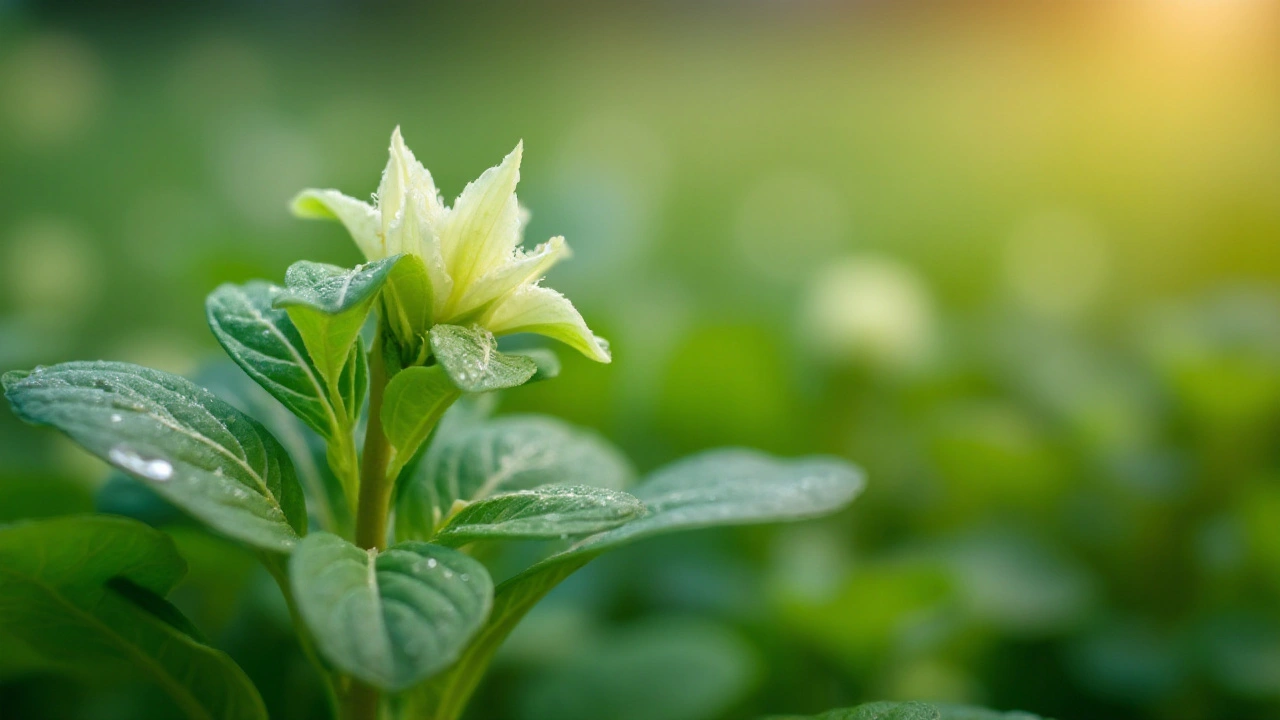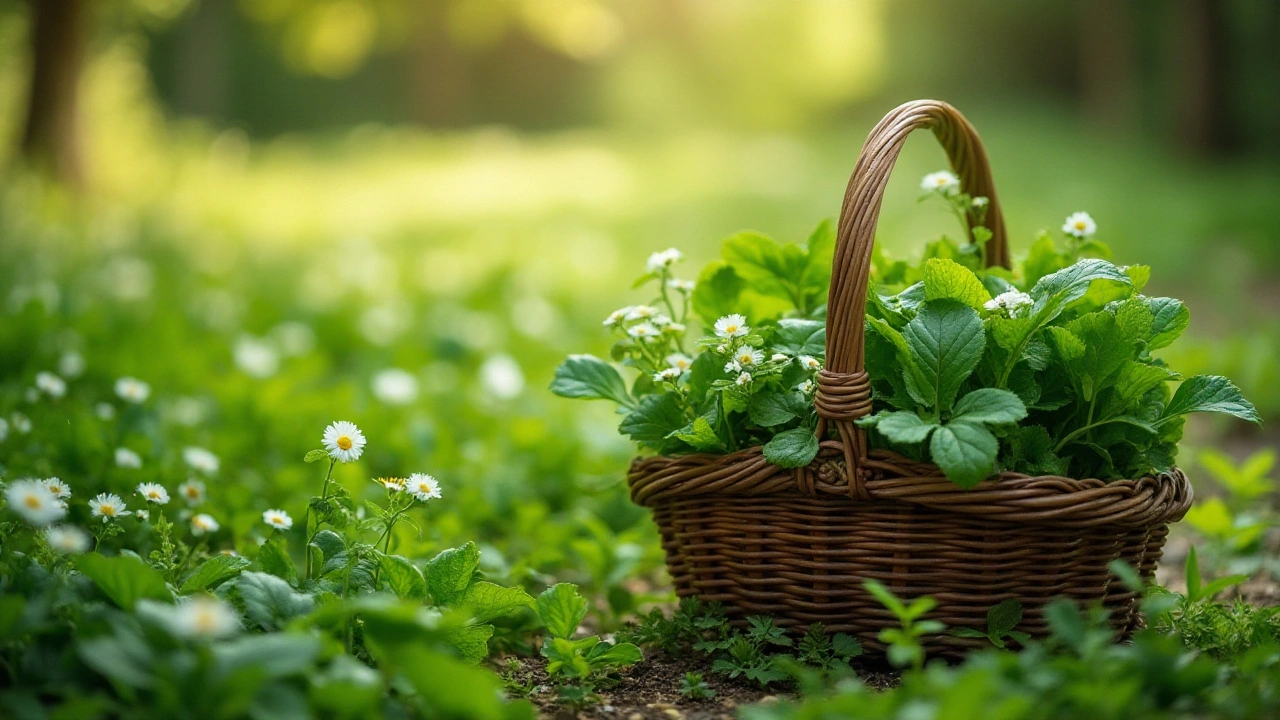Wild radish, a humble yet potent plant, has been making waves in the world of natural health remedies. This plant is packed with nutrients and offers an array of benefits that can do wonders for your health and well-being. It's time to explore what wild radish has to offer.
Often regarded as a mere garden weed, wild radish is actually a powerhouse of vitamins and minerals. Many people are unaware of its potential to boost overall health, and it's right there in our backyards, waiting to be discovered. Not only does it support our immune system, but it's also great for digestion and skin health.
Getting to know wild radish is easy. With a little guidance, you can identify and gather it safely. Its leaves and flowers are the parts we often use, and there are creative ways to incorporate them into daily meals. Whether you're a gourmet chef or a busy parent, there are recipes fit for everyone.
Taking advantage of wild radish is simple, and it is relatively safe for most people. However, it's always best to use any new food with caution. Let's delve deeper into this wonderful plant and unlock the secrets of integrating wild radish into your life.
- Introduction to Wild Radish
- Nutritional Profile and Health Benefits
- Gathering and Identifying Wild Radish
- Incorporating Wild Radish into Your Diet
- Potential Side Effects and Precautions
Introduction to Wild Radish
Wild radish, known scientifically as Raphanus raphanistrum, is a fascinating plant native to the Mediterranean region. Yet, it's been seen sprouting and thriving in various parts of the world. Often dismissed as a mere weed, this resilient little plant holds numerous secrets within its modest, earthy presence. The wild radish belongs to the Brassicaceae family, sharing its lineage with well-loved, nutritious vegetables like broccoli, kale, and cabbages. However, unlike its more famous relatives, its presence has been less celebrated. Yet, those who venture into the realm of wild radish will discover a health boon hiding in plain sight.
This plant is easily recognizable by its delicate white to yellow flowers, often tinged with purple veins, which can bring a splash of color to any landscape where they choose to grow. The wild radish exhibits an incredible adaptability, thriving along roadsides, wastelands, and even pushing through cracks in the urban jungle. Its deep green leaves—sometimes offering a hint of spiciness akin to its cultivated cousin, the radish—are brimming with life-sustaining qualities. As a key player in the aeration of soil and an important pollinator attractant, wild radish plays a subtle yet significant role in our ecosystem.
During ancient times, this remarkable plant was not only appreciated for its robustness but also cherished for its medicinal properties. Healers and herbalists from centuries past often turned to wild radish as a trusted companion in their natural apothecary. "Wild radish has served as more than just a staple in ancient herbal remedies—it has been a lifeline," says Dr. Eliza Sycamore, a historical botanist and author of Plants That Shaped the World. Wild radish was often used in infusions to ward off common ailments or in poultices for topical applications, testament to its versatility.
Surprisingly, the wild radish plant isn’t just an afterthought when it comes to nutritional value. Packed within its fibrous leaves are essential vitamins such as Vitamin C, which is instrumental in supporting our immune system, alongside a blend of minerals like potassium and calcium, both vital for maintaining healthy bodily functions. There is also a notable presence of dietary fiber, which aids digestion—a quality shared among its close relatives in the brassica family. According to recent studies, these nutrients, together with an assortment of beneficial compounds naturally present in wild radish, can support cardiovascular health and even act as a protective buffer against chronic diseases.
Around the globe, in various culinary traditions, wild radish makes an appearance in kitchens not merely as a health supplement but as a flavorful ingredient. In its native Mediterranean region, the leaves and flowers frequently grace salads with their sharp, peppery notes. While in parts of Asia, the seeds are often harvested for their oil, which is renowned for its savory taste and health-enhancing properties. This cross-cultural appreciation adds to the wild radish's tale, reflecting its adaptability and the universal acknowledgment of its benefits.
Nutritional Profile and Health Benefits
When looking at the humble Wild Radish, what's remarkable is how packed it is with essential nutrients that can make a significant difference to our well-being. Wild radish is a veritable cornucopia of vitamins and minerals, including vitamin A, vitamin C, potassium, and calcium. Its nutrient-dense profile means that even a small amount can go a long way in promoting health. Consuming wild radish regularly can lead to improvements in immune function, thanks to its high vitamin C content. This vitamin is known for its role in boosting the body’s defense mechanisms against infections. Moreover, vitamin A supports healthy vision and skin, making wild radish a boon for those seeking natural ways to enhance their health.
Many people might overlook the crucial dietary fibers present in wild radish. These fibers are instrumental in promoting good digestion and maintaining a healthy gut. By adding wild radish to your diet, you stand to gain not only from its nutritional excellence but also its ability to help regulate bowel movements and prevent constipation. This, in turn, can reduce the risk of developing more severe gastrointestinal issues over time. Interestingly, wild radish possesses compounds that are known to suppress inflammation, which plays a key role in preventing chronic diseases. Regular intake might also aid in managing blood sugar levels, as preliminary research suggests its potential effectiveness in regulating insulin and glucose processing.
Studies have indicated that wild radish contains various antioxidants that contribute to its health benefits. These antioxidants are crucial in combating oxidative stress, which can lead to cell damage and aging. By including wild radish in your diet, you might slow down the aging process while improving skin health and potentially warding off conditions like heart disease and cancer. There’s also a strong argument for joyously celebrating its anti-bacterial properties. Farmers and holistic practitioners have long known that wild radish can provide protection against specific bacterial infections, thus adding another layer of benefit to its already impressive health credentials.
Dr. Emily Richardson, a leading nutritionist, noted in a recent symposium, "Wild radish is not just a weed; it's a wild gift to our kitchens and our health. The synergy of micronutrients in this plant works wonders on the human body."
The leaf’s low-calorie content makes it ideal for those who are weight-conscious. You can consume it raw in salads or cooked to blend its taste with other vegetables. Owing to its fiber and water content, wild radish can be immensely satiating without contributing too significantly to your daily caloric intake. This assists in managing weight while keeping your nutrition on point. A study published in the Journal of Nutritional Science highlighted how root vegetables, including wild radish, help in weight management due to their inherent ability to satisfy hunger while providing necessary nutrients. Such insights underscore the importance of making wild radish a staple in your diet.
A deeper dive into the health benefits of wild radish also reveals its role in detoxification. This plant potentially assists in liver function enhancement and serves as a natural diuretic, helping the body to efficiently expel toxins through urination. By aiding the liver, wild radish contributes significantly to an overall feeling of vitality and rejuvenation. Many herbalists suggest including wild radish in cleansing regimes, supported by anecdotal evidence of increased energy levels and well-being.

Gathering and Identifying Wild Radish
The journey to reaping the health benefits of wild radish begins with properly identifying and gathering it in its natural habitat. This plant is frequently found in open fields, roadsides, and even abandoned lots. It's quite common in temperate regions, where it thrives under the sun’s rays. Recognizing it is relatively simple, but it demands a keen eye and a bit of knowledge. The wild radish, also known scientifically as Raphanus raphanistrum, boasts a few distinct features that make it stand out from other plants.
This plant typically grows to about one to three feet tall, adorned with lobed leaves that somewhat resemble those of cultivated radishes, albeit more rugged in shape. The wild radish loves to flaunt its clusters of four-petaled flowers, which exhibit a charming range of colors, from white to yellow, and even shades of pink and lavender. These hues hint at the plant’s rich genetic diversity. Seasoned foragers will tell you that the stems can be slightly hairy and that the taproot is slender compared to its edible garden cousin.
While it’s tempting to assume that all radish-like plants are safe to consume, it’s critical to ensure proper identification. A pro-tip is to look for the seed pods, which are narrower and more elongated than other radish varieties. Unlike the pods of garden radishes, these cannot be cracked open easily; instead, they are slightly spicy and delightful to the palate. Always remember that when foraging for wild plants, it's wise to take guidance from reliable field guides or join a local foraging group for expert advice.
"Foraging is an ancient tradition, one that connects you with nature’s pantry – sustainable and rewarding if done responsibly," says renowned ethnobotanist Mark Peifer of the Botany Conservation Trust.
Timing is pivotal for picking wild radish. The best time to gather is during spring and early summer when the plants are young and tender—the growth period when they have optimum flavor and nutrition. To collect, use a pair of scissors or a sharp knife to cut the leaves and flowers. This method not only ensures a clean cut but also encourages regrowth, promoting a sustainable approach to utilizing wild resources.
Before venturing out, take note of local regulations regarding foraging; some public lands may have restrictions. Additionally, ensure you avoid areas that may have been exposed to pollutants or pesticides, such as roadside verges or plots adjacent to intensive agricultural practices. Equipping yourself with knowledge and practice, gathering wild radish can be a rewarding experience, connecting you deeply with nature and bringing a unique flair to your meals.
Incorporating Wild Radish into Your Diet
Wild Radish is not only abundant but also highly adaptable when it comes to culinary uses. Exploring this often underestimated plant opens up a world of nutrient-packed dishes that are both delicious and healthy. Imagine starting your day with a vibrant wild radish smoothie. By blending a handful of its fresh leaves with a banana, a scoop of yogurt, and a dash of honey, you can create a morning booster that invigorates your start of the day. It's a tasty way to revive your immune system, thanks to its rich Vitamin C content.
Salads are another excellent canvas for wild radish. Its slightly peppery leaves pair well with sweeter components like cherry tomatoes and apple slices. Toss in some nuts and goat cheese, drizzle with olive oil and vinegar, and you’ve got yourself a refreshing, nutrient-dense salad. The natural earthy flavor balances nicely with sweet and tart elements, adding dimension to your plate. An added benefit? Its flowers are edible too — they not only garnish but also add a zingy hint to your salad creations.
Soups and stews are another avenue in which the health benefits of wild radish shine. As winter rolls in, crafting a hearty soup with wild radish leaves, potatoes, and onions can be a comforting indulgence. The leaves add depth and a nutritious boost — think spinach but with a unique twist. Sauté the leaves with garlic and onions before adding them to broth, and watch as they lend their vibrant color and nutrient profile to your dish. For something heartier, try adding them to a beef stew early on so they meld into the base as it slowly simmers.
Beyond these, consider using wild radish in pestos or stir-fries. Blend the leaves with walnuts, Parmesan, and a touch of olive oil for a wild radish pesto that's delicious over pasta or as a spread. Alternatively, toss its crisp stems and leaves into a quick stir-fry with tofu or chicken, ginger, and soy sauce for an Asian-inspired meal that’s as healthy as it is quick. These methods preserve the plant's nutrient integrity while introducing its unique taste to your palate.
Cooking with nature’s bounty like wild radish is empowering. It encourages a deeper connection with the environment and a respect for resources that are often overshadowed in the grocery store spotlight. As Rachel Carson eloquently put it,
"Those who contemplate the beauty of the earth find reserves of strength that will endure as long as life lasts."By incorporating wild radish into your meals, you are not only enriching your diet but also partaking in a sustainable practice that values and utilizes local flora.

Potential Side Effects and Precautions
Exploring the health benefits of the wild radish is an exciting adventure, but it's important to acknowledge its potential side effects and understand the precautions necessary for safe consumption. While this natural remedy is largely beneficial, individuals must be aware of how their bodies may react. The seeds, in particular, contain substances that, if consumed in excessive amounts, can cause irritation or discomfort in some people. It's worth noting that the leaves and flowers are generally safer to eat. For those unfamiliar with wild radish, it's wise to start with small amounts to see how your body responds before including it in your regular diet.
One significant concern some people have is related to allergies. Similar to other plants in the Brassicaceae family, wild radish might trigger allergic reactions in sensitive individuals. Such reactions could include itching, skin rashes, or more severe respiratory symptoms. A sensible step for anyone with known plant allergies is to consult a healthcare provider before introducing wild radish into their diet. Even those without known allergies should remain vigilant for any unexpected reactions upon consuming this plant.
Another consideration is the potential for wild radish to interfere with certain medications. Like many foods high in vitamin K, it can affect blood clotting processes, thus reducing the efficacy of anticoagulant drugs. Therefore, individuals on such medications should approach wild radish with caution and seek medical advice beforehand. As always, keeping open lines of communication with health professionals ensures safer dietary changes, especially when exploring new herbs or plants.
Environmental factors also play a role in the safe consumption of wild radish. Growing along roadsides and fields, this plant can sometimes absorb pollutants or pesticides from its surroundings. Consuming contaminated wild radish might pose risks, making it essential to gather from safe, organic environments. Enthusiasts often find that cultivating wild radish safely in a home garden offers control over quality and safety.
"We must remember that nature, while bountiful, requires respect and understanding," says renowned herbalist Dr. Ellen Parks.
For those considering wild radish for the first time, cooking methods can also mitigate potential risks. Most harmful substances are minimized through cooking, making it a safer choice for inclusion in various recipes. Steaming or boiling the leaves often retains their nutritional value while reducing any potential adverse effects. The bottom line: being informed and cautious enhances the positive experience of incorporating wild radish into one's dietary regimen.






Comments(9)